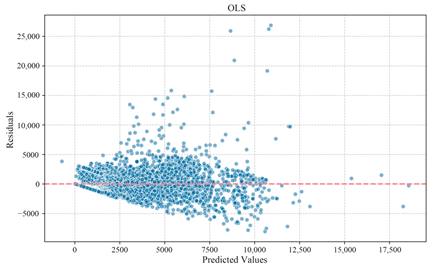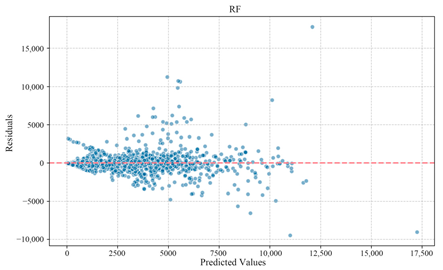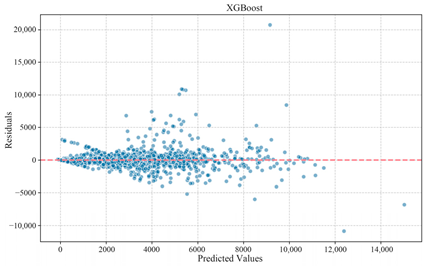Abstract
As global population ageing accelerates and urban governance increasingly prioritizes livability and age-friendly services, the 15-minute living circles concept has emerged as a key strategy to support daily walking exercise, social participation, and healthy ageing. In waterfront cities, blue spaces function as important everyday settings that contribute to environmental quality, recreational opportunities, and ecosystem services for older adults. This study extends the conventional 5D built environment framework by explicitly integrating blue space elements and characterizes older adults’ walking behaviour using four indicators across two dimensions (temporal and preference-based). We applied XGBoost regression and multiscale geographically weighted regression (MGWR) to identify threshold effects and spatial heterogeneity of blue space elements on older adults’ walking, and used K-means clustering to delineate blue space advantage zones within living circles. The results show that blue space accessibility, street scale, and water body density exhibit significant nonlinear relationships with older adults’ walking. Blue space elements shape walking behavior differentially and with pronounced spatial variation: in some living circles they encourage longer, recreational walks, while in others they stimulate high-frequency, short-distance walking. These effects produce destination preferences and time period preferences. The study highlights the pivotal role of blue spaces in age-friendly living circles and, based on spatial synergies among blue space advantage zones and their components, proposes renewal strategies including expanding the functional reach of blue spaces, constructing blue slow-walking corridors, and integrating blue–green symbiotic networks.
1. Introduction
As urbanization policies shift from rapid spatial expansion toward resident-centered development, cities are moving their emphasis from purely physical growth to addressing social needs and improving public welfare []. In this context, living circle planning has become a central element of territorial spatial governance. The “15-minute city” concept-introduced at the inaugural World Cities Day Forum in 2014-advocates a home-centred, highly accessible, walkable service system that satisfies residents’ basic daily needs []. The concept of the “living circle” originated in urban planning and sociology. Although its principles are closely tied to residents’ daily commutes and social interactions, it was not initially applied to research on healthy ageing and older adults’ walking exercise; rather, it described the spatial extent of residents’ routine activities. With global population ageing, scholars have increasingly integrated living circle planning with older adults’ walking and now recognize the concept’s practical significance for mitigating urban sprawl, addressing climate challenges, and promoting nature-friendly urban environments. At the micro scale, within high-density built environments, accessible nature-friendly spaces—such as urban green and blue spaces—within the living circle enhance older adults’ living conditions, encourage outdoor exercise, and reduce dependence on motor vehicles, yielding both health and social benefits. Melbourne, Australia, pioneered the “20-min living circle” to respond to rapid population growth and ageing by promoting low-carbon modes of travel such as walking and cycling []. Since then, countries including the United Arab Emirates, Australia, and China have proposed integrating public infrastructure services, social care, health management, and home-based care for older adults within neighborhood boundaries to create more convenient, healthy, inclusive, and resilient community living circles.
Blue spaces are outdoor environments characterized by natural or artificial water bodies. Unlike conventional “waterfront spaces,” which primarily emphasize human use and ecological conservation, the blue space concept foregrounds the effects of water exposure on residents’ physical and mental health [,]. In 2016, the EU Horizon-funded BlueHealth project was launched in Europe to develop more ecological and sustainable strategies for enhancing well-being in urban areas with inland waterways and coastal margins []. This initiative initiated systematic, interdisciplinary, quantitative research into the health impacts of blue spaces and helped place the topic on public-health and urban-planning agendas []. However, in transit-oriented 15-minute living circle planning, blue spaces are often included in spatial layouts but remain poorly integrated with pedestrian networks, service facilities, and everyday walking behaviors, limiting their potential to improve community health and support ageing populations. Integrating the health benefits of blue spaces into living circle planning therefore represents an important evolution of spatial-resource allocation toward a health-oriented framework. At its core, the living circle concept seeks to optimise public resource provision to support walkability and livability, while blue spaces—as distinctive natural elements—can substantially enhance residents’ use of those resources. Specifically, blue spaces can transform basic walkability within living circles into attractive, sustainable “places people enjoy visiting” [] through multisensory experiences and by encouraging physical activity. When integrated organically, blue spaces convert water bodies from static landscape features into dynamic environments that stimulate regular outdoor activity and facilitate psychological restoration among older adults.
In summary, this paper examines how high-quality blue ecological resources can be transformed into accessible health resources for older adults within the context of walking exercise in 15-minute living circle. It analyzes how blue space elements interact with other built environment components in typical waterfront cities and how these interactions ultimately shape older adults’ walking patterns. By revealing the match between blue space resource allocation and walking behaviour across diverse living circle types, the study proposes an age-friendly community planning methodology centered on blue spaces. This methodology aims to increase older adults’ willingness to engage in walking, thereby facilitating the transformation of high-density waterfront cities from mere places of residence into optimal living environments.
2. Literature Review
2.1. 15-Minute Living Circle, Blue Space, and Daily Activities of Older Adults
Implementation and research emphasis on the 15-minute city concept vary across countries (Table 1). Existing studies of the “15-minute living circle” primarily examine built environment satisfaction, street vitality, and green-space accessibility. Jiang et al. [] assessed street walkability for older adults using the accessibility of 15-minute service facilities and reported significant spatial heterogeneity in neighborhood walkability that correlates with perceived safety and levels of greening. Other studies have explored heterogeneous effects of factors such as land-use mix [], public-transit stop configuration [], and traffic-related pollution [] on older adults’ walking patterns from an urban-planning perspective.

Table 1.
Evolution of 15-minute city development.
Blue spaces within the living environment are important determinants of older adults’ health, with accessibility acting as a key mediator of wellbeing benefits []. Grace et al.’s empirical analysis of waterways and park water bodies found that the magnitude of blue spaces’ effect on residents’ physical activity depends on high spatial accessibility and the quality of walking environments []. Such factors indirectly shape specific behaviours by influencing subjective travel intentions. For older adults—who are especially sensitive to environmental cues—the accessibility and walkability of waterfront areas (for example, environmental cleanliness and perceived safety) substantially determine the extent to which they gain physical activity and psychological stress reduction benefits from blue spaces []. Serra further showed that inequities in accessibility are major drivers of differential benefit distribution, and recommended prioritising access for vulnerable groups to compensate for these disparities [].
Research has increasingly substantiated the impact of blue space characteristics on physical activity among older adults. Multiple studies have observed that, compared to large water bodies located far from residential areas, small-scale blue spaces—such as canals, community ponds, and ecological revetments—with comprehensive amenities near homes are more effective in promoting daily activities like walking and socializing [,,]. Such environments typically support outdoor activities among older adults by providing continuous walking paths, low-gradient surfaces, and shaded social areas []. In contrast, larger rivers and lakes, characterized by extended shorelines and open landscapes, tend to encourage more vigorous physical activities and provide psychological restoration, making them popular gathering spaces for middle-aged and younger adults [,]. Due to their unique socio-cultural and emotional value, blue spaces often become primary walking destinations for older adults within their living circles.
Moreover, under specific conditions—such as during high-intensity activities or prolonged outdoor stays—blue spaces have been shown to offer more significant improvements in environmental comfort and resident health compared to urban green spaces [,]. However, most current research remains focused on the effects of water bodies on environmental issues such as climate regulation, PM2.5 reduction, and urban heat island mitigation [,], with limited attention directed toward the relationship between rivers, lakes, and health behaviors among older adults. Furthermore, in living circle planning, designers often treat rivers and lakes as spatial boundaries, resulting in activity infrastructure that is generally less developed in these blue spaces than in green parks []. This oversight leads to the neglect of their potential age-friendly value and benefits as blue spaces.
2.2. Nonlinear Responses and Threshold Mechanisms of the Built Environment on Older Adults’ Walking
The quality of the built environment within a 15-minute living circle substantially influences older adults’ activity levels and travel willingness. However, many studies concentrate narrowly on optimizing public-service facility allocation [] and thereby understate the context-dependent complexity of older adults’ travel behavior. Environmental factors often influence behavior only after exceeding specific thresholds, after which marginal effects may decline; some variables also require interactions with other factors to produce measurable impacts [,]. As a result, facility planning can fall into a “more is better” logic or rely on simplistic quantitative metrics, lacking assessments of appropriateness and differentiation [,].
Empirical work documents such nonlinearities and thresholds. A study in Beijing identified a significant threshold effect between living-circle “settlement rates” and built environment attributes, with the nonlinear relationship moderated by physical environmental conditions [,]. Liu et al. [] reported pronounced nonlinear marginal effects of the built environment on resident mobility. Yang et al. [], using a walking environment satisfaction survey of 1012 older residents in Chengdu and a RF model, found a nonlinear positive association between built environment satisfaction and walking satisfaction among seniors. These findings provide methodological bases for defining intervention thresholds and implementing differentiated resource allocation in people-centered urban governance, helping to avoid reductive conclusions such as “more green space is always better” or “more transport development is always better,” and thereby supporting more nuanced age-friendly planning and decision making.
2.3. Research Gap
Existing studies have mainly evaluated the effects of living circles on residents’ walking pattern and healthy behavior through green space, transportation, and public-service facilities []. However, systematic investigations focusing on urban blue spaces (inland rivers and lakes) as integral elements of living circles remain limited []. (1) Existing research has predominantly emphasized the climate regulation and pollution mitigation functions of coastal or large-scale water bodies, while the direct relationship between inland blue spaces and residents’ daily physical activity remains underexplored [,]. (2) Furthermore, few studies have systematically evaluated the accessibility, service functions, and synergistic effects of blue spaces with surrounding facilities []. Water bodies are often regarded merely as administrative or landscape boundaries, rather than as potential resources for active travel []. (3) Methodologically, the prevalent reliance on linear models and macro-level statistics limits the ability to detect non-linear relationships, such as threshold and saturation effects, as well as interactions among key variables. In addition, detailed characterization of walking behavior in older adults remains scarce []. These methodological and conceptual limitations lead to generalized policy recommendations, which lack actionable thresholds and prioritization criteria to support differentiated, age-friendly living circle planning.
To address these research gaps, this study investigates the 15-minute living circle in Tianjin’s Binhai New Area. It aims to address the following core research questions: (1) How do blue space elements interact with other built environment factors within the neighborhood to influence walking activity among older adults? (2) Does blue space exhibit significant spatial heterogeneity in shaping older adults’ walking patterns, and if so, what are the characteristic spatial differentiation patterns? (3) How can functional zoning be implemented based on blue space advantages and older adults’ walking preferences to inform age-friendly planning within the living circle?
3. Materials and Methods
3.1. Research Framework
This study established an analytical framework to elucidate the complex relationships between blue space elements, the built environment within living circles, and walking behavior among older adults. The framework integrates both intrinsic driving mechanisms and spatial differentiation characteristics (Figure 1). First, an evaluation index system for the built environment of living circles was developed, incorporating blue space elements. A database of walking trips among older adults was then constructed by integrating multi-source data with field questionnaire surveys. Second, a progressive analytical approach was employed to investigate the utility-driven role of blue space elements in influencing walking trips. Finally, guided by blue health principles, this study proposes environmental enhancement strategies for 15-minute living circles, with the following specific objectives:
- (1)
- To quantitatively identify the threshold effects and interaction relationships between blue space and built environment elements that influence walking activities among older adults.
- (2)
- To reveal the spatial heterogeneity of the impact of blue space elements on walking behavior within elderly living circles.
- (3)
- To classify living circles based on their blue space advantage levels and identify synergistic configuration patterns of blue space elements.
- (4)
- To propose targeted, age-friendly environmental enhancement strategies tailored to different types of blue space functional zones.

Figure 1.
Research framework flowchart.
3.2. Study Area
Tianjin Binhai New Area is located on the eastern coast of Tianjin (Figure 2). The district covers approximately 2270 km2, has a coastline of about 153 km, and contains roughly 700 km2 of water bodies and wetlands. According to the 2020 Seventh National Population Census, residents aged 60 and above account for about 17.15% of the permanent population in Binhai New Area, indicating a pronounced ageing trend that makes the area a suitable case for studying older adults’ mobility within living circles. In response to demographic shifts and spatial development needs, the “Tianjin Binhai New Area Living Circle Planning and Design Guidelines” (hereinafter, the Guidelines) were formulated and released in 2023. Based on the demarcations outlined in the Guidelines and census population distribution, this study focuses on several living circle units within the district with a relatively high concentration of older adults. Existing living circles in the area generally exhibit several challenges []:
- (1)
- Public spaces and activity facilities are monotonous, lacking diversity in venues for daily activities, and underutilizing ecological resources such as green spaces, rivers, and lakes.
- (2)
- Public service facilities are insufficiently accessible, and conflicts between pedestrian pathways and vehicular roads compromise safety perceptions and travel willingness among older adults.
- (3)
- In some areas, pedestrian networks and blue infrastructure are poorly connected to community service facilities, thereby limiting walking trips oriented toward blue space experiences.

Figure 2.
Study area: (a) 63 Study units; (b) Functional zoning of living circles in the Guidelines; (c) development status of living circles in the Guidelines.
The 15-minute living circle serves not only as a spatial unit for public service provision but also as the fundamental setting for residents’ daily activities and health behaviors. Within this context, blue spaces extend beyond their ecological and landscape functions, acting as primary destinations for walking exercises and key venues for health promotion among older adults. Furthermore, variations in blue space types, accessibility, and integration with the built environment across different living circle units shape distinct travel preferences and behavioral patterns among older adults in each unit. Accordingly, this study adopted the living circle unit classification specified in the Guidelines, dividing the Binhai New Area into 63 analytical units. This approach enables an effective examination of the practical impact of blue spaces as daily life resources on the walking exercise and health of older adults.
3.3. Variable Selection and Data Collection
3.3.1. Variable Selection
To better characterize the study subjects, variables were selected across three dimensions: walking behavior, social attributes, and the built environment. Walking behavior was described using four indicators in two categories—temporal and preferential—including duration of walking for exercise purposes, walking frequency, destination preference, and time period preference []. This approach emphasizes the role of active walking in promoting healthy aging. Basic social attributes, including gender, age, and residential status, were incorporated to control for group differences and provide contextual background.
For the built environment, this study drew on the 5D model proposed and refined by Cervero et al. [], which systematically characterizes the influence of the built environment on travel behavior across five dimensions: density, diversity, design, destination accessibility, and distance to Transit. This model has become a key reference in transportation studies and continues to be updated []. Building on this foundation, an evaluation framework was constructed by integrating urban blue space elements with site characteristics []. Initially, 17 potential indicators were selected. Variables showing high correlation (r > 0.9) were excluded based on Pearson correlation analysis (Figure 3). Subsequently, multicollinearity was assessed (Table 2), leading to the final indicator set used for modeling (Table 3).
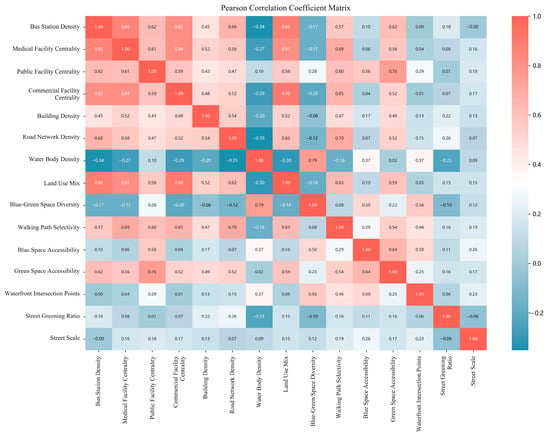
Figure 3.
Pearson correlation analysis.

Table 2.
Multicollinearity test.

Table 3.
The 5D model of built environment integrating the factors of blue space elements.
3.3.2. Data Collection
Data on walking behavior were collected between February and May 2025 through a combination of offline questionnaires and field observations (Table 4). The questionnaire was structured into two parts: walking characteristics and basic sociodemographic attributes. Participants consisted of living circle-dwelling adults aged 60 years or older, who volunteered for the study and provided signed informed consent. The sample size was determined based on the statistical principle (the sample size is approximately 10 times the number of variables, i.e., approximately 1500 samples). This target was then allocated proportionally across the 63 living circle units, aiming for approximately 30 valid questionnaires per unit and resulting in an overall target sample size of 1890. In total, 1572 valid questionnaires were ultimately collected, which sufficiently exceeds the common empirical threshold for regression analysis. All collected data demonstrated satisfactory reliability and validity. Data pertaining to the built environment and blue spaces were obtained from open geographic data platforms, including OpenStreetMap, the Amap, and Landsat-8 remote sensing imagery. All data preprocessing and spatial analyses were performed using ArcGIS 10.8 and ENVI 5.6.

Table 4.
Basic statistics of surveyed samples.
3.4. Technical Routes
This study adopted a dual-model analytical approach (Figure 4). First, a literature review was conducted to identify health-related blue space elements that influence residents’ activities. These elements were integrated into the established 5D built environment model to construct an evaluation framework for walking mobility among older adults within living circles. Second, an XGBoost regression model was applied to assess the relative importance, threshold effects, and interaction relationships of built environment and blue space variables on walking features. Third, key blue space elements were selected to develop a multiscale geographically weighted regression (MGWR) model, which was used to analyze the spatial heterogeneity of their impacts on walking activities. Finally, K-means clustering analysis was performed based on the influence weights of blue space elements, enabling the classification of blue space advantage zones and elucidating the associations linking blue space factors with walking behavior among older adults.
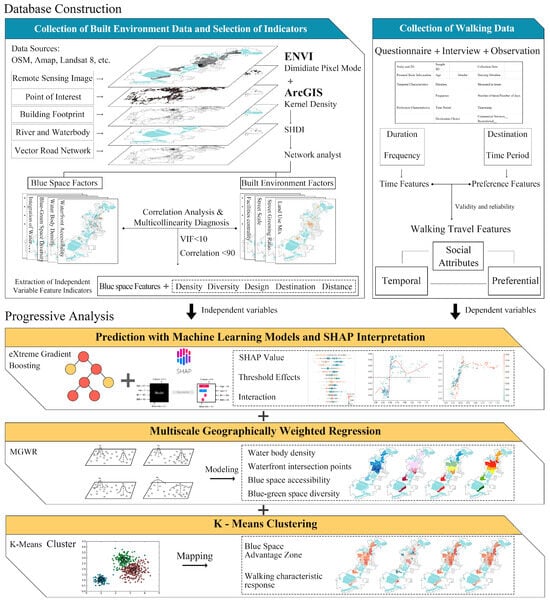
Figure 4.
Technical routes.
3.5. Methodology
To characterize the nonlinear and interactive effects of the built environment on older adults’ walking, we adopted a two-pronged methodological approach that combined machine learning interpretation with spatial econometrics.
First, we employed eXtreme Gradient Boosting (XGBoost) to model the relationships between built environment predictors and walking outcomes. XGBoost is a machine learning algorithm based on the gradient boosting framework, widely applied in high-dimensional regression tasks. We trained XGBoost with appropriate tuning and validation procedures to ensure robust predictive performance, then applied SHAP to interpret the trained models: SHAP values were used to quantify global feature importance, to derive marginal-effect plots for detecting thresholds and nonlinear responses, and to examine interaction effects among predictors. This combination allowed identification of critical variables, threshold points, and interactive mechanisms that were not readily captured by linear methods []. The equations are as follows:
In Equation (1), denotes the predicted value for sample i after the t-th iteration, represents the predictions made by the first t − 1 trees, and refers to the model of the t-th tree. In Equation (2), Obj is the objective function, where represents the loss function that measures the discrepancy between the predicted value and the true value , and is the regularization term that controls the complexity of the model.
Second, to accurately capture the potential spatial heterogeneity in the influence of blue space elements on the walking activities of older adults across different living circle units, a multiscale geographically weighted regression was employed. This model allows for the examination of the multiscale effects of these elements on walking behavior. The equation is as follows:
In the equation, represents the value of the dependent variable at position i; denotes the value of the independent variable at position i; represents the regression analysis point i; represents the intercept term; constitutes the regression coefficients.
Finally, the K-means clustering method was applied to classify living circle units into distinct blue space advantage zones. The clustering was based on the combined weights derived from two sources: the feature importance scores generated by the XGBoost model and the spatial influence intensity coefficients obtained from the MGWR analysis. This procedure enabled the identification of three zone types: core advantage zones, secondary advantage zones, and potential zones. Furthermore, the synergistic configuration patterns of blue space elements within each zone type were analyzed using the following equation:
In the equation, represents the Euclidean distance for discriminating clustering clusters; denotes the blue space feature weight in XGBoost; signifies the spatial influence intensity weight of blue space elements in MGWR; n indicates the number of variable dimension.
4. Results
4.1. The Nonlinear Response of Walking to the Built Environment of 15-Minute Living Circle
Following a comparison of three candidate models, Ordinary Least Squares (OLS), Random Forest (RF), and XGBoost, the XGBoost model was selected as the primary regression tool due to its superior overall performance (Table 5). Prior to model development, the four walking feature variables were preprocessed: temporal variables were normalized, and binary variables were encoded to a [0, 1] range.

Table 5.
Comparison of model residuals.
4.1.1. Feature Importance
The XGBoost analyses produced distinct importance patterns across the four walking indicators. For walking duration (Figure 5a), street scale emerged as the most influential predictor: both very low and very high street scale values were associated with longer walking times, whereas moderate street scale values were associated with shorter walking times. High centrality of public facilities and greater blue space accessibility were also associated with reduced walking duration. Some individual samples, however, displayed opposite local effects, suggesting spatial heterogeneity.
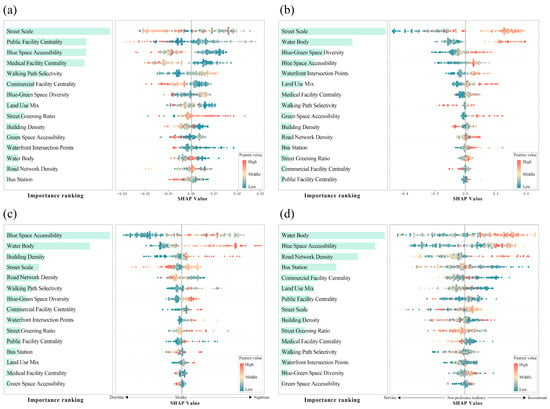
Figure 5.
Feature importance in the older adults’ walking behavior, dots: blue indicates low values of the independent variable, red indicates high values of the independent variable, and yellow indicates median values of the independent variable: (a) Walking duration; (b) Walking frequency; (c) Time period preference; (d) Destination choice.
For walking frequency (Figure 5b), street scale again ranked highly: moderate street scale was associated with higher travel frequency. Water body density, blue–green space diversity, and blue space accessibility each showed positive associations with walking frequency, indicating that blue space elements were important drivers of daily physical activity among older adults.
Regarding time periods (Figure 5c), blue space accessibility and water body density were the dominant predictors of period preferences. Low accessibility coupled with high water body density was associated with a tendency to go outside in the midday or nighttime; conversely, high accessibility with low density was associated with daytime activity. Street scale also influenced time-of-day choices, consistent with prior spatiotemporal behavior studies [].
For destination preference (Figure 5d), blue space accessibility and water body density were positively associated with visits to public recreational spaces. In areas with lower blue space accessibility, older adults exhibited a higher propensity to visit commercial service facilities. Road network density and blue space accessibility showed interactive effects on destination choice, and in some contexts older adults still chose recreational destinations even when accessibility was low—indicating that recreational public spaces also served as important attractors.
4.1.2. Threshold of Built Environment Feature Effects
The results indicated that built environment influences on older adults’ walking were nonlinear and varied by walking features (Figure 6) []. Street scale exhibited pronounced threshold effects on walking duration and walking frequency but had a smaller role in preferential related dimensions. Blue space factors explained a larger share of variance in walking time periods and destination choices.
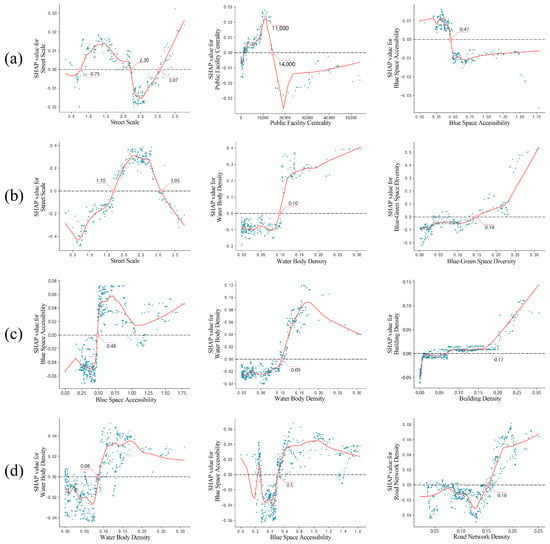
Figure 6.
Threshold effects of built environment feature on older adult walking mobility. The blue dots represent each individual sample, and the red line represents the average trend of the samples: (a) Walking duration; (b) Walking frequency; (c) Time period preference; (d) Destination choice.
Specifically, street scale displayed multiple threshold relationships with walking duration: walking duration increased when street scale approached 0.75, the rate of increase slowed near 1.5, duration decreased around 2.3, and walking time rose markedly beyond 3.07. In addition, the influence of blue space accessibility on walking duration exhibited a distinct threshold effect. A critical point was observed at an accessibility index of approximately 0.47, which corresponds to a 28-min walking distance. Beyond this threshold, the positive association with walking duration began to weaken. This finding indicates that positioning blue spaces within a 28-min walking radius is pivotal for effectively promoting walking behavior among older adults. For walking frequency, street scale positively influenced frequency within approximately 1.7–3.05, with an apparent optimum in the 2.1–2.5 range; frequency declined outside this range. When water body density exceeded 0.10, older adults’ perception of blue space increased and walking frequency rose notably.
Blue space elements exerted stronger threshold effects on time period preference and destination choice. Blue space accessibility produced a behavioral shift at 0.48: highly accessible blue spaces were associated with daytime activities, whereas more distant blue spaces were used in the evening-likely reflecting attempts to avoid high daytime temperatures and traffic exposure. For destination choice, a water body density threshold near 0.08 corresponded with a marked increase in visits to public recreational places, suggesting an optimal perceptual range of approximately 0.08–0.10 for blue space influence within living circle units.
4.1.3. Interaction Between Blue Space Factors and the Built Environment
Interaction analyses revealed that blue space factors were conditioned by other built environment attributes, with street scale frequently moderating blue space benefits (Figure 7).
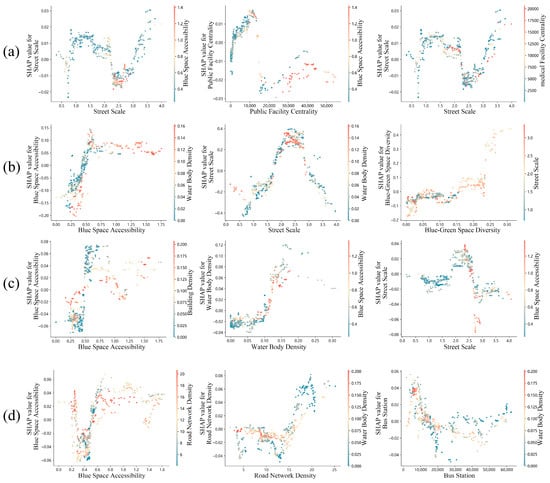
Figure 7.
Interaction effects between the built environment factors and blue space factors: (a) Walking duration; (b) Travel frequency; (c) Travel time period; (d) Destination decision.
For temporal features, when the street width-to-height ratio was approximately 2.3–2.6 and blue space accessibility was high, walking duration was substantially reduced. A comparable interaction was observed between the medical facilities’ centrality and water body density. Conversely, when streets were either excessively wide or narrow, overall walking duration declined and the motivating effect of blue space was attenuated. At intermediate street scales, blue spaces contributed additional motivation for walking.
For time period preference, interactions between building density and blue space accessibility varied by period: low-density waterfronts primarily promoted morning and nighttime activities, whereas high-density waterfronts had stronger midday effects, reflecting differences in tranquility and supporting services. Furthermore, positive interactions between water body density and blue space accessibility were associated with increased nighttime blue space visits, a pattern consistent with perceived improvements in nocturnal comfort and air quality. For destination choice, transportation convenience partially offset limited walkability: high road network density enabled older adults to access recreational venues even where accessibility was low. Interactions between public-transport and blue space factors also influenced destination preferences, indicating joint determination of spatial behavior by transport and blue space accessibility.
In summary, the results demonstrated that blue space factors did not act in isolation but were amplified or suppressed through interactions with street scale, building density, road networks, and public transportation. The identified nonlinearities, thresholds, and interactions exhibit spatial heterogeneity and therefore have implications for differentiated, age-friendly living circle configurations.
4.2. Spatial Heterogeneity in Older Adults’ Walking Behavior
To further reveal the spatial influence mechanisms of blue space factors on walking behavior among older adults, this study first applied the global Moran’s I tests on four categories of walking behavior among the older adult. The results indicated that, except for time period (Moran’s I = 0.247, p = 0.081), three walking features—walking duration, frequency, and destination—confirmed significant spatial autocorrelation with varying degrees of regional clustering. Although time period exhibited a weak spatial clustering trend, the results did not reach statistical significance, necessitating further investigation into its clustering patterns. These findings preliminarily proved the applicability of spatial econometric models for analyzing most core walking features in this context (Table A1).
Subsequently, MGWR model was constructed and compared against ordinary least squares (OLS) and geographically weighted regression (GWR) models. The comparison showed that the MGWR model provided superior explanatory power and model fit in capturing spatial behavioral patterns [], while also revealing multiscale spatial effects of blue space factors on walking trips among older adults (Table 6).

Table 6.
Model fitting results.
Regarding the temporal characteristics of walking (Figure 8a,b), blue space factors exerted similar spatial effects on both the duration and frequency of walking among older adults. In northern living circles dominated by rivers and small water bodies, increased water body density was associated with significantly longer walking durations and a higher frequency of daily exercise outings. This suggests that in areas where appropriately scaled blue spaces are well-integrated into the community, higher water density effectively encourages older adults to incorporate blue spaces environments into regular, brisk walking routines. The presence of waterfront intersection points was found to extend walking duration by improving water accessibility, yet it concurrently reduced daily walking frequency. This pattern implies that in areas with high water availability, older adults tend to engage in less frequent but more dedicated, medium-to-long duration activities. The positive effect of blue space accessibility on walking intensity was notably concentrated in central urban areas. Living circles with higher blue space accessibility and greater walking convenience were more likely to support prolonged, high-frequency walking patterns. Furthermore, a comparison with the functional zoning outlined in the Guidelines (Figure 2b) revealed that older adults residing near industrial-type living circles generally exhibited lower walking motivation and exercise intensity. In these areas, the promotive effects of water body density and blue–green space diversity on both walking duration and frequency were significantly constrained. This indicates that facility-oriented blue space factors can be susceptible to suppression by other built environment factors, a finding consistent with the interaction effects observed in earlier analysis.
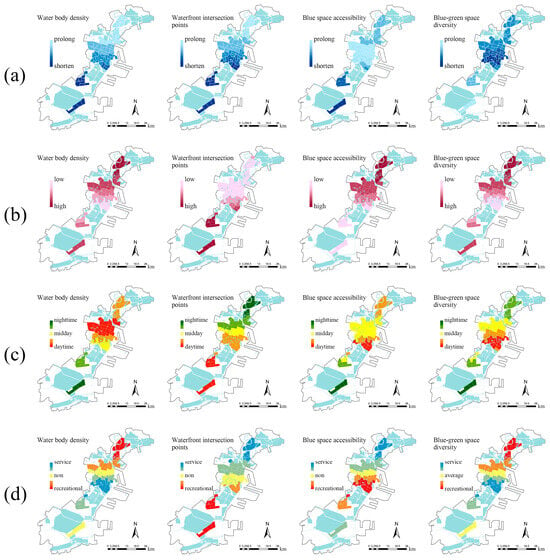
Figure 8.
Spatial heterogeneity of blue space factors’ effects: (a) Walking duration; (b) Walking frequency; (c) Time period; (d) Destination choice.
Analysis of walking preferential features (Figure 8c,d) revealed considerable spatial overlap in the effects of water body density and blue–green space diversity on destination choices among older adults. This overlap defined a distinct geographical pattern: walking preferences in the central living circle were moderate, the northern living circle showed a preference for recreation and relaxation venues, and the southern central district, characterized by high POI density, leaned toward commercial service locations. In contrast, waterfront intersection points and blue space accessibility exhibited opposing spatial gradients. This pronounced differentiation suggests that different blue space elements play fundamentally distinct roles in guiding the destination choices of older adults. In densely developed southern areas, high commercial concentration improved daily service accessibility, triggering more walking activities associated with shopping, dining, and entertainment. In these contexts, the dominance of service facilities in destination choice appeared to suppress the attractiveness of blue infrastructure as standalone recreational spaces, creating a functional opposition between northern and southern blue space elements. Regarding walking time period preferences, elevated water body density was generally associated with increased daytime activity across the entire study area. However, improvements in waterfront intersection points, blue space accessibility, and blue–green space diversity primarily promoted daytime walking within riverside living circles. The stronger attraction of flowing water bodies to daytime walking may be attributed to better spatial visibility and risk anticipation under daylight conditions, which effectively alleviates safety concerns among older adults []. Additionally, the daytime social atmosphere fostered by flowing water environments also contributed to increasing walking motivation [].
4.3. Delineation of Blue Space Advantage Zones and Synergistic Configuration Patterns Based on Elderly Travel Characteristics
Building on the significant influence and spatial heterogeneity of blue space factors on walking behavior among older adults revealed by the preceding analysis, this study further applied the K-means clustering. This approach facilitated the translation of associated insights into planning-oriented applications at the living circle level. The clustering procedure utilized four core indicators: water body density (WBD), blue space accessibility (BA), waterfront intersection points (WIP), and blue–green space diversity (BGSD). These indicators were weighted according to their variable importance (from the XGBoost model) and spatial influence strength (from the MGWR model) to objectively identify distinct blue space advantage patterns and synergistic configuration patterns across the living circle units.
The clustering results identified three primary zone types (Figure 9): (1) Core advantage zones, located near major water systems with superior natural endowments, were primarily driven by high WBD, BA, WIP and BGSD, supporting high-intensity, prolonged walking activities. (2) Secondary advantage zones, concentrated in well-developed existing communities with dense road networks, were characterized by limited intrinsic blue space attributes but compensated via high WIP and BA, providing accessible waterfront opportunities. (3) Potential zones were distributed in areas distant from core water systems or with underutilized water resources, exhibiting the weakest overall blue space advantages. These synergistic patterns revealed three dominant configurations within the core advantage zones: WBD + BA + BGSD, WBD + WIP + BGSD, and WIP + BGSD. Areas characterized by these multi-element couplings demonstrated significantly stronger spatial clustering effects than those dominated by a single element.
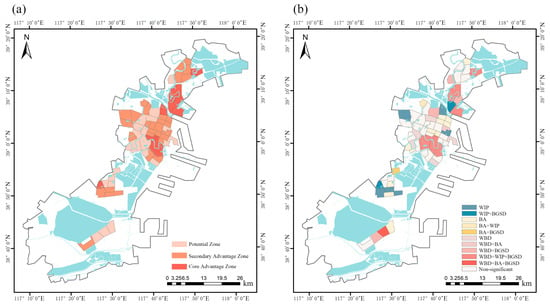
Figure 9.
Delineation of blue space advantage zones and synergistic configuration patterns for blue space factors in Tianjin Binhai New Area: (a) Blue space advantage zone delineation; (b) Blue space factor synergistic configuration patterns.
To validate the behavioral implications of the identified blue space advantage zones, the zoning results were overlaid with clusters of walking features (Figure 10). A significant spatial coupling was observed: living circle units with longer walking durations and higher frequencies were predominantly located within core and secondary advantage zones. This finding corroborates the positive role of blue space in promoting walking intensity, consistent with the threshold effects identified earlier. Distinct walking preferences also emerged across different zones. Walking time period preferences (either daytime or nighttime) were mainly distributed within core advantage zones and riverside living circles. In contrast, walking without a distinct daytime or nighttime bias were more concentrated in secondary advantage and potential zones—areas generally farther from major water bodies. This pattern suggests that the appealing blue space environment in core zones serves as a primary attractor, readily establishing fixed peak periods for activities such as morning exercises and evening strolls. In zones with scarcer blue resources, walking behavior is less influenced by specific environmental cues at set times, resulting in a more evenly distributed temporal pattern. Regarding destination choice, older adults in core advantage zones showed a preference for public recreational venues, especially those near water bodies. Meanwhile, secondary advantage zones exhibited a stronger commercial orientation, likely due to their higher concentration of commercial services.
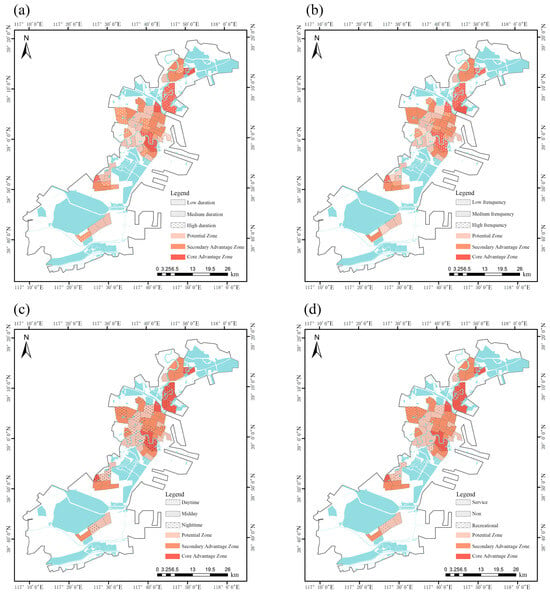
Figure 10.
Overlay analysis of walking features in older adults: (a) Walking duration; (b) Walking frequency; (c) Time period; (d) Destination choice.
In summary, the K-means clustering analysis successfully delineated the spatial distribution of blue space endowments, identified synergistic configuration patterns and their corresponding behavioral outcomes, and translated the complex association into a actionable planning framework. This spatial-functional classification provides a concrete basis for subsequent blue space-oriented enhancements to age-friendly, walkable living circle environments.
5. Discussion
5.1. Patterns of Walking for Older Adult Within a 15-Minute Living Circle
In the temporal dimension, the duration of walking among older adults was more strongly influenced by urban infrastructure factors, including the availability of public service facilities, street scale, and accessibility to blue spaces. With advancing age, declines in physical and cognitive function can impair spatial perception of nearby environments []. Consequently, areas characterized by high blue space accessibility and straightforward route designs were more conducive to establishing patterns of longer and more frequent walking. Travel frequency showed the strongest association with ecological and residential environment factors, such as street scale, water body density, and blue–green space diversity, reflecting older adults’ general willingness to walking and activity levels. In contrast, low street connectivity and inadequate infrastructure—such as poor nighttime lighting or unsafe sidewalks—elevate the risk of accidents, thereby suppressing walking frequency []. While prior studies have reported that commercial facility density affects walking frequency [], this study did not observe a significant correlation. This may indicate that in walking trips primarily aimed at exercise, commercial activities (e.g., grocery shopping, purchasing daily necessities, or buying breakfast) are often incorporated as ancillary behaviors within older adults’ daily exercise routes, underscoring the composite and utilitarian nature of their walking patterns. Appropriate and proactive walking exercise helps mitigate health risks, delay physical decline, reduce loneliness, and enhance social engagement. The World Health Organization recommends that older adults accumulate at least 150 min of moderate-intensity aerobic activity per week to maintain health []. Future studies could incorporate health status and life satisfaction indicators, or employ structural equation modeling, to further reveal the complex relationships among the built environment, walking behavior, and health outcomes in this population [].
Sample statistics indicated that older adults primarily walked during daytime hours for purposes such as daily shopping, morning exercise, picking up grandchildren, and medical appointments. This pattern aligns with the general travel habits observed among older adults in most Chinese cities []. Analysis revealed that their walking time period preferences were mainly associated with factors including street scale, blue space accessibility, and water body density. When perceived walking conditions were poor, seniors tended to travel earlier in the morning to mitigate traffic-related safety risks. This behavior reflects how older adults strategically optimize their access to daily resources while adapting to physical limitations. In terms of spatial distribution, living circles favored for daytime walking typically exhibited higher residential density and greater land-use mix, suggesting a preference among older adults for conducting activities closer to home during daytime hours []. Regarding destination choice, several factors exerted significant influence: water body density, public transportation, commercial facility centrality, and blue space accessibility []. Higher transportation accessibility and functional integration enabled older adults to fulfill multiple needs within a single trip. Specifically, within living circle units characterized by dense road networks and abundant public transit stops, older adults showed a stronger preference for service-oriented destinations. In contrast, in areas with relatively sparse transit stops, they tended to favor public recreational venues. This pattern indicates a lower reliance on public transit during active walking exercises that are primarily motivated by exercise or leisure. Although this study did not directly examine the relationship between bus transfer behavior and cross-unit walking, the observed patterns suggest that future research should more clearly distinguish between “daily accessible blue spaces” (used within the immediate living circle) and “destination-oriented blue spaces” (requiring public transport to reach). Such a distinction would help to more fully elucidate the decision-making logic underlying older adults’ walking preferences within and beyond their local living circles.
5.2. Associations of Blue Space Factors Influencing Walking Patterns Among Older Adults
The analyses revealed pronounced threshold and nonlinear interaction effects of built environment attributes on older adults’ walking. Street scale, centrality of public facilities, building density, water body density, and blue space accessibility exhibited nonlinear relationships with walking patterns; in many cases an environmental attribute produced a detectable inflection point after which its marginal effect changed and interactions with other attributes emerged (Figure 11). Prior research has shown that walking duration is positively associated with density and land use mix but that this positive relationship attenuates as density increases, implying that excessively high facility density may constrain mobility []. Consistent with this, blue space factors displayed significant, predominantly positive interactions with other built environment characteristics, with street scale frequently acting as a key moderator. Studies have also documented a symbiotic relationship between blue and green spaces: higher water coverage commonly coincides with improved green-space quality and greater blue–green diversity, although attractiveness tends to stabilize beyond a certain proportion [,]. In the present study, when an environmental feature exceeded its threshold, its direct effect intensified and secondary interactive effects with co-occurring features became apparent; across these joint relationships blue space metrics often assumed a dominant role.
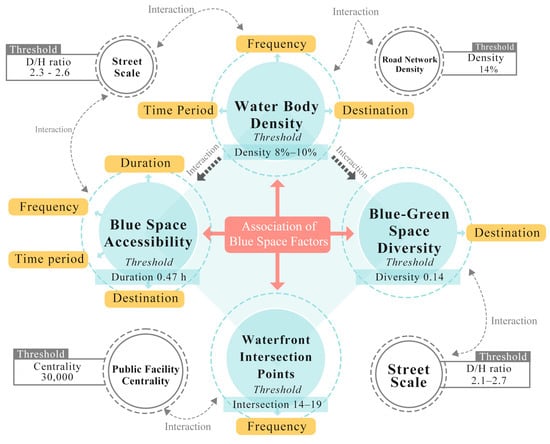
Figure 11.
Association of blue space factor action, threshold and interaction effects.
Specifically, water body density significantly influenced the travel frequency, time period, and destination choices of older adults. A positive synergy was observed between water body density, street scale, and road network density, encouraging activity near water bodies. Spatially, increasing water body density was particularly beneficial in residential units with initially limited blue space access, where it enhanced both walking duration and frequency, and reinforced preferences for daytime walking and recreational destinations. Living circle units with a high degree of waterfront intersection points significantly promoted walking frequency among older adults. This intersection point provides more opportunities for water-based activities, thereby increasing their activity motivation. This was especially evident in units adjacent to rivers and large water bodies, where it fostered a pattern of high-frequency, short-duration walking exercises during the daytime. Blue space accessibility emerged as a key determinant of walking behavior. High accessibility not only offers convenient spaces for walking and recreation but also boosts older adults’ confidence and comfort []. It demonstrated considerable importance across all four walking features, although the direction of its effects varied, underscoring its complex role in shaping distinct walking patterns. Conversely, blue–green space diversity primarily affected walking frequency. While high density blue–green spaces significantly promoted daytime outing, field surveys revealed that these areas often lacked essential amenities such as nighttime lighting, protective guardrails, and sufficient seating. These deficiencies can diminish perceived safety and may even trigger aquaphobia in some individuals, thereby reducing the willingness of older adults to walking at night. Furthermore, this study identified a specific response threshold for walking behavior related to street scale []. A street width-to-height ratio between 1.7 and 3.05 was associated with longer walking durations, with an optimal range of 2.1 to 2.5. Notably, within the narrower band of 2.3 to 2.5, blue space factors began to exert a significant positive influence, further enhancing walking willingness.
5.3. Recommendations for the Renewal and Development of the 15-Minute Living Circle in Binhai New Area
Systematically integrating blue spaces into urban-scale studies on the built environment and resident behavior offers a foundational strategy for age-friendly renewal in waterfront cities such as Tianjin, Hangzhou, and Suzhou. This study confirms that, compared to simply increasing land use intensity or facility density, enhancing blue spaces through integrated “water-city coupling” planning can more effectively unlock the latent health value of the urban environment, creating more attractive recreational and social spaces for older adults [,]. Based on the influence associations and spatial differentiation patterns of blue spaces identified in this research, future planning should avoid one-size-fits-all approaches. Instead, targeted interventions should be implemented according to the specific blue space endowments of different units. Adopting this spatially explicit strategy is essential for constructing truly age-friendly and sustainable 15-minute living circles [].
5.3.1. Core Advantage Zones
In core advantage zones, the coordinated allocation of elements—such as water body density, waterfront intersection points, and blue–green space diversity—can significantly amplify blue space benefits. Planning efforts should ensure the quantity, quality, and accessibility of blue spaces while aiming to foster all-day pedestrian vitality. This can be achieved by implementing age-friendly refinements, such as introducing small water features (e.g., rain gardens) in community parks, increasing the intersections between park pathways and water bodies, and repurposing existing water bodies to create integrated blue–green parks. Concurrently, the proportion and walkability of pedestrian spaces within the built environment should be optimized. Enhancing nighttime lighting and safety facilities, along with establishing vibrant nodes for rest, social interaction, and services along key routes connecting blue spaces to residential areas, will help transform these zones into premier destinations that support high-frequency, extended-duration, and round-the-clock activities for older adults, while extending their positive influence to wider urban contexts.
5.3.2. Secondary Advantage Zones
Secondary advantage zones are primarily concentrated in older residential living circles, where blue space accessibility and waterfront intersection points play the most critical roles. Interventions here should focus on strengthening systematic connections and functional coupling between blue spaces and high-density built-up areas. This includes constructing blue slow-moving corridors and pedestrian overpass to provide direct access from community cores to water bodies, thereby bridging the last mile and achieving the goal of making blue spaces “visible and accessible.” Meanwhile, integrated facilities that combine basic commerce, public transit links, and recreational functions should be deployed at key transportation hubs and waterfront interfaces. This approach addresses the ancillary activity needs generated by older pedestrians and effectively converts the area’s transport convenience into tangible blue space accessibility and diverse activity opportunities.
5.3.3. Potential Zones
Potential zones are characterized mainly by industrial-ecological living circles with limited water resources and lack significant blue space configuration advantages. However, some areas within these zones show responsiveness to improvements in blue space accessibility and water body density. Planning should therefore seek to redefine the value of scattered blue space resources. Priority should be given to low-cost ecological upgrades of overlooked micro-water bodies, focusing on enhancing their perceptibility and accessibility. By constructing a “blue–green symbiosis” network [], these peripheral spaces can be integrated into community-based recreational anchors. This strategy will help gradually cultivate the overall environmental appeal of the area and stimulate older adults’ willingness to engage in outdoor activities.
5.4. Limitations and Prospects
This study provides several insights into the influence of the built environment and blue spaces on walking feature among older adults; however, some limitations should be addressed in future work. (1) While this study focused primarily on environmental influences, it did not fully control for all potential confounding factors. Individual sociodemographic characteristics, such as physical health, disability status, caregiving responsibilities, and residential self-selection, also profoundly shape walking behavior. Although these were considered during variable selection and model interpretation, future studies would benefit from incorporating more detailed individual-level data or employing mediation models to better disentangle the causal pathways between environmental exposures and personal activity choices []. (2) The measurement of walking chain dynamics was limited. This research focused on proactive walking for outdoor exercise within local living circles and did not track whether older adults transferred to public transport to reach more distant destinations. Consequently, the observed shorter walking durations could indicate either truly shorter trips or a shift toward using public transit for exercising at preferred locations farther away. Future work could record complete activity-walking chains to more accurately map activity patterns and potential modal substitutions. (3) The study’s temporal coverage and microenvironmental measurement could be enhanced. The analysis used daytime and nighttime as temporal units and did not examine seasonal variations (e.g., monthly or quarterly). Thus, it was unable to compare how walking behavior changes across different periods—such as potentially longer duration but lower frequency in winter, and the opposite in summer [,]. Spatially, the study relied mainly on living circle-level and meso-scale data, lacking fine-grained measures of pedestrian-scale microenvironments (e.g., pavement smoothness, street interface quality). Future research could integrate mobile sensing and street-view imagery to achieve more precise quantification of both temporal rhythms and micro-scale environmental features []. (4) The quantification of blue space factors could be more multidimensional. Current metrics emphasized physical aspects such as water body density, accessibility, and blue–green space diversity but did not comprehensively capture perceptual and functional dimensions—including older adults’ perceptions of water or blue–green combination, environmental quality, and ecological value []. Subsequent research should develop more integrated subjective–objective indicators to refine the understanding of how blue space influences health behaviors.
6. Conclusions
As urban development shifts toward a more people-oriented model, the renewal of living circle-scale built environments has emerged as a vital pathway to support aging in place and enhance residents’ well-being. Although many waterfront cities have begun integrating blue spaces, such as waterfront greenways and wetland parks, into public service systems, planning approaches often prioritize ecological and aesthetic functions. There remains a limited systematic understanding of the complex mechanisms by which blue spaces influence residents’ daily health behaviors, particularly the walking activity of older adults. This gap between planning practice and scientific evidence constrains the full realization of blue spaces as key health-promoting resources within living circles. Consequently, the findings of this study hold broad relevance for most cities situated along water bodies. Blue spaces are not exclusive assets of coastal cities but are long-standing, indispensable components of the urban fabric in the vast majority of settlements—including inland lake cities such as Chicago, Chongqing, and Toronto. While many urban water bodies suffered from isolation and pollution during industrialization, which suppressed their potential as healthy ecological spaces, the ongoing transformation of urban development paradigms offers an opportunity to restore their value. Therefore, systematically integrating blue spaces into living circle planning represents not only the reuse of ecological resources but also the restoration of urban historical continuity and a reaffirmation of residents’ fundamental rights to a healthy environment. This approach is essential for advancing global sustainable urban development and public health.
Using the 15-minute living circle in Tianjin’s Binhai New Area as a case study, this research integrated multi-source big data, questionnaire surveys, and field observations to construct a built environment assessment framework incorporating blue space features. By applying machine learning (XGBoost) and spatial econometric (MGWR) models, the study yields three principal conclusions: (1) The classical 5D built environment model was effectively expanded by systematically integrating blue space factors. This integration demonstrates that blue space holds a level of importance comparable to traditional built environment factors in explaining walking behavior among older adults, thereby providing a more comprehensive theoretical perspective and practical assessment tool for living circle planning. (2) The analysis reveals nonlinear threshold effects and significant interaction relationships between blue space and older adults’ walking characteristics. The utility of blue space is not a simple matter of presence or absence; rather, it is activated or suppressed under specific environmental conditions, exhibiting clear spatial heterogeneity in both the intensity and direction of its influence. This underscores that blue space, as a health-promoting resource, requires synergistic configuration with surrounding environmental features—such as street scale and transport facilities—to maximize its efficacy. (3) K-means spatial clustering successfully identified functionally distinct zones based on blue space advantage, confirming that different zones correspond to differentiated behavioral response patterns among older adults. This outcome provides a scientific basis for implementing targeted, precision interventions of blue space factors within age-friendly living circles, enabling resource optimization and tailored planning strategies.
Author Contributions
Conceptualization, X.Z., L.C. and Y.Y.; methodology, L.C., Y.Y.; software, Y.Y.; validation, X.Z., L.C.; formal analysis, Y.Y., L.C.; investigation, X.Z., L.C. and Y.Y.; resources, L.C.; data curation, Y.Y.; writing—original draft preparation, X.Z., L.C.; writing—review and editing, X.Z., Y.Y.; visualization, Y.Y.; supervision, X.Z., L.C.; project administration, X.Z.; funding acquisition, X.Z. All authors have read and agreed to the published version of the manuscript.
Funding
This research was funded by the Provincial Demonstration Course Project for Graduate Students Establishment grant number (KCJSX2025021).
Institutional Review Board Statement
Not applicable.
Informed Consent Statement
Not applicable.
Data Availability Statement
The data used in this paper mainly came from the Ministry of Housing and Urban-Rural Development of the People’s Republic of China (https://www.mohurd.gov.cn/, accessed on 22 July 2025), the EARTHDATA (https://www.earthdata.nasa.gov/, accessed on 3 May 2025), the Ctrip (https://www.ctrip.com/, accessed on 13 May 2023).
Acknowledgments
Thank you to Yi Yu and Lei Cao for their assistance in data collection and literature review.
Conflicts of Interest
The authors declare no conflicts of interest.
Abbreviations
The following abbreviations are used in this manuscript:
| XGBoost | eXtreme Gradient Boosting |
| MGWR | Multiscale Geographically Weighted Regression |
| OLS | Ordinary Least Squares |
| WBD | Water Body Density |
| BA | Blue Space Accessibility |
| WIP | Waterfront Intersection Points |
| BGSD | Blue–Green Space Diversity |
Appendix A

Table A1.
Spatial Autocorrelation Analysis.
Table A1.
Spatial Autocorrelation Analysis.
| Global Moran’s I | Z-Score | p Value | Spatial Autocorrelation Report | |
|---|---|---|---|---|
| Duration | 0.596 | 7.082 | 0.000 | 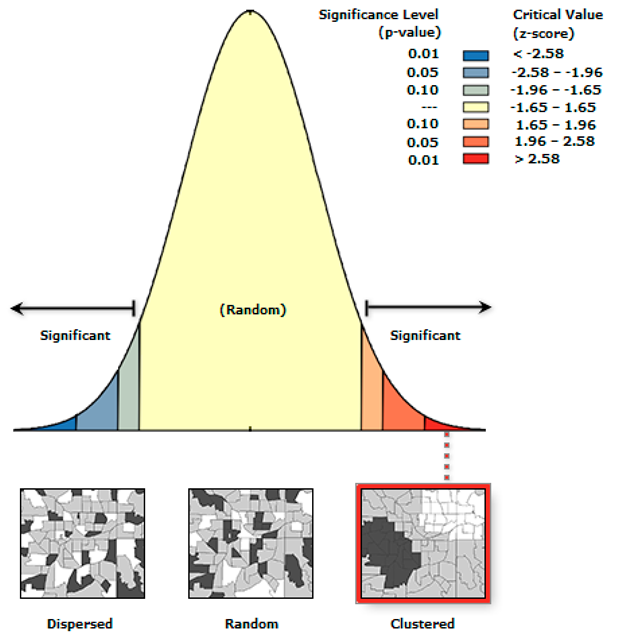 |
| Frequency | 0.585 | 8.935 | 0.000 | 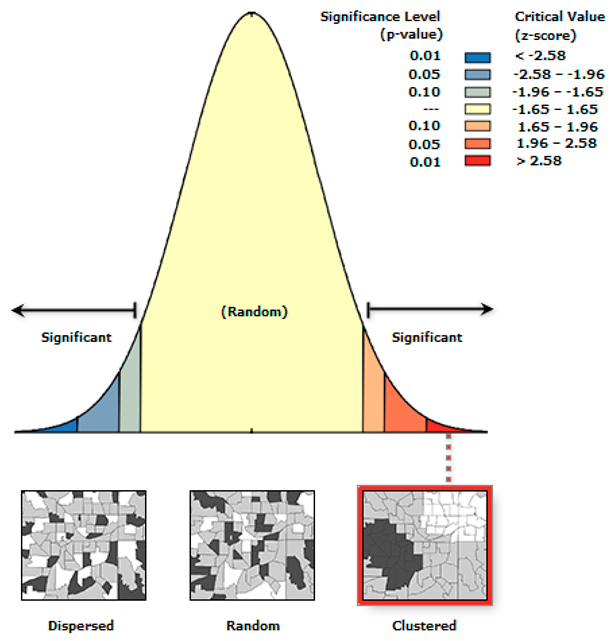 |
| Time period | 0.247 | 1.742 | 0.081 | 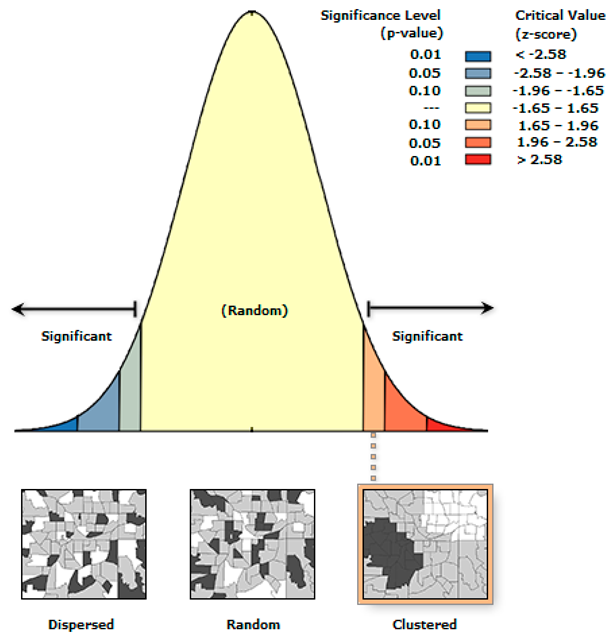 |
| Destination | 1.193 | 2.015 | 0.043 | 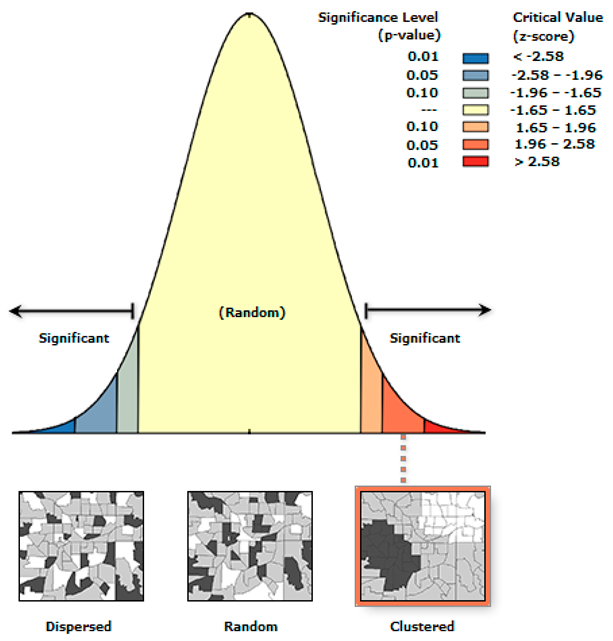 |
References
- Luo, X.; Chai, Y. Concept, Connotation and Planning Methods of X-Minute City. Urban. Plan. Int. 2024, 39, 12–22. [Google Scholar] [CrossRef]
- Chai, Y.; Li, C. Urban Life Planning: From Research to Practice. City Plan. Rev. 2019, 43, 9–16+60. [Google Scholar]
- White, M.P.; Elliott, L.R.; Gascon, M.; Roberts, B.; Fleming, L.E. Blue space, health and well-being: A narrative overview and synthesis of potential benefits. Environ. Res. 2020, 191, 110169. [Google Scholar] [CrossRef]
- Volker, S.; Kistemann, T. The impact of blue space on human health and well-being—Salutogenetic health effects of inland surface waters: A review. Int. J. Hyg. Environ. Health 2011, 214, 449–460. [Google Scholar] [CrossRef]
- Grellier, J.; White, M.P.; Albin, M.; Bell, S.; Elliott, L.R.; Gascón, M.; Gualdi, S.; Mancini, L.; Nieuwenhuijsen, M.J.; Sarigiannis, D.A.; et al. BlueHealth: A study programme protocol for mapping and quantifying the potential benefits to public health and well-being from Europe’s blue spaces. BMJ Open 2017, 7, e016188. [Google Scholar] [CrossRef]
- Gascon, M.; Zijlema, W.; Vert, C.; White, M.P.; Nieuwenhuijsen, M.J. Outdoor blue spaces, human health and well-being: A systematic review of quantitative studies. Int. J. Hyg. Environ. Health 2017, 220, 1207–1221. [Google Scholar] [CrossRef]
- Geiger, S.J.; White, M.P.; Davison, S.M.C.; Zhang, L.; McMeel, O.; Kellett, P.; Fleming, L.E. Coastal proximity and visits are associated with better health but may not buffer health inequalities. Commun. Earth Environ. 2023, 4, 166. [Google Scholar] [CrossRef]
- Jiang, Z.; Wu, C.; Chung, H. The 15-minute community life circle for older people: Walkability measurement based on service accessibility and street-level built environment—A case study of Suzhou, China. Cities 2025, 157, 105587. [Google Scholar] [CrossRef]
- Xiao, Z.; Chai, Y.; Zhang, Y. Overseas Life Circle Planning and Practice. Planners 2014, 30, 89–95. [Google Scholar]
- Huang, H.; Zhou, D.; Wang, Y. An Analysis of the Spatial Organization of Community Life-cycle under Residential Morphological Categories. Urban. Plan. Forum 2021, 2, 94–101. [Google Scholar] [CrossRef]
- Chen, Y.; Yang, B. Study on Aging Suitability for Healthy Travel in Daily Life Unit Based on Traffic Factors: A Case Study of the Central Urban Area of Nanjing. Chin. Landsc. Archit. 2023, 39, 91–96. [Google Scholar] [CrossRef]
- Alawadi, K.; Anabtawi, R.; Ismail, I.; Alshehhi, M. From local to global: Uniting neighborhood planning units for more efficient walks. Transp. Res. Interdiscip. Perspect. 2024, 23, 101014. [Google Scholar] [CrossRef]
- Shen, Z.; Lin, X.; Ma, Y. On the Combination of Japanese Urban Master Plan and “Life Circle” Concept in Recent Years. Urban. Rural. Plan. 2018, 6, 74–87. [Google Scholar] [CrossRef]
- Mun, J.; Lee, J.S.; Kim, S. Effects of urban sprawl on regional disparity and quality of life: A case of South Korea. Cities 2024, 151, 105125. [Google Scholar] [CrossRef]
- Wu, Y. The Role of Urban Design in Urban Development: Taiwan’s Urban Design in Comparative Perspective. Ph.D. Thesis, University of Strathclyde, Glasgow, UK, 1999. [Google Scholar]
- Sun, D.; Chai, Y.; Zhang, Y. The Definition and Measurement of Community Life Circle: A Case Study of Qinghe Area in Beijing. Urban. Dev. Stud. 2016, 23, 1–9. [Google Scholar]
- Hu, J. Reform of Urban Planning and Thoughts over The Coordination of Urban Plan and Land Use in Shanghai. City Plan. Rev. 2010, 34, 20–25. [Google Scholar]
- He, T.; He, Q.; Tan, S. Research on Planning Paths for Urban Blue Spaces to Promote Elderly Health. South. Archit. 2022, 5, 54–63. [Google Scholar] [CrossRef]
- Olitsky, M.; Lerman, Y.; Avineri, E. Analysis of Stated Preferences for Accessible Services and Commerce in a Walkable Distance from Home. Transp. Res. Procedia 2017, 27, 1001–1008. [Google Scholar] [CrossRef]
- Du, S.; Qian, B.; Wang, J.; Wang, L. Impact of Built Environment on Walking Efficiency from the Perspective of Healthy Cities: A Case Study Based on the Core Area of Chengguan District in Lanzhou City. South. Archit. 2024, 10, 49–59. [Google Scholar] [CrossRef]
- Yang, Z.; Yang, J.; Chen, S. Neighborhood Effects of Blue Space in Historical Environments on the Mental Health of Older Adults: A Case Study of the Ancient City of Suzhou, China. Land 2024, 13, 1328. [Google Scholar] [CrossRef]
- Wang, L.; Sani, N.M. The impact of outdoor blue spaces on the health of the elderly: A systematic review. Health Place 2024, 85, 103168. [Google Scholar] [CrossRef] [PubMed]
- Guan, J.; Ismail, S.B.; Salih, S.A.; Mohamed, W.S.W.; Hussain, N.B. The Role of Blue Space in Enhancing Mental Health and Well-Being Among Older Adults: A Systematic Review. Sustainability 2025, 17, 3749. [Google Scholar] [CrossRef]
- Guo, N.; Xia, F.; Yu, S. Enhancing Elderly Well-Being: Exploring Interactions between Neighborhood-Built Environment and Outdoor Activities in Old Urban Area. Buildings 2024, 14, 2845. [Google Scholar] [CrossRef]
- Yang, L.C.; Yu, B.J.; Liang, P.P.; Tang, X.L.; Li, J. Crowdsourced Data for Physical Activity-Built Environment Research: Applying Strava Data in Chengdu, China. Front. Public Health 2022, 10, 883177. [Google Scholar] [CrossRef]
- Bergou, N.; Hammoud, R.; Smythe, M.; Gibbons, J.; Davidson, N.; Tognin, S.; Reeves, G.; Shepherd, J.; Mechelli, A. The mental health benefits of visiting canals and rivers: An ecological momentary assessment study. PLoS ONE 2022, 17, e0271306. [Google Scholar] [CrossRef] [PubMed]
- Li, X.; Jia, B.; Wang, Z.; Li, T.; Feng, F. Residential heat environment in relation to blue-green space sustainability in Beijing, China. Urban For. Urban Green. 2024, 102, 128577. [Google Scholar] [CrossRef]
- Ge, C.; Yang, F.; Wang, H.; Xu, L. Shaping Built Environments for Health-Oriented Physical Activity: Evidence from Outdoor Exercise in Dongguan, China. Buildings 2025, 15, 2812. [Google Scholar] [CrossRef]
- Zhang, Y.; Ge, J.; Bai, X.; Wang, S. Blue-Green space seasonal influence on land surface temperatures across different urban functional zones: Integrating Random Forest and geographically weighted regression. J. Environ. Manag. 2025, 374, 123975. [Google Scholar] [CrossRef]
- Cao, W.; Wang, L.; Li, R.; Zhou, W.; Zhang, D. Unveiling the nonlinear relationships and co-mitigation effects of green and blue space landscapes on PM2.5 exposure through explainable machine learning. Sustain. Cities Soc. 2025, 122, 106234. [Google Scholar] [CrossRef]
- Afentou, N.; Jackson, L.; Andrade, L.F.; Elliott, S.; Hull, K.; Shepherd, J.; Frew, E. Valuing Blue Spaces for Health and Wellbeing from the Community Perspective. Sustainability 2024, 16, 5222. [Google Scholar] [CrossRef]
- Zhang, W.; Li, C.; Luo, X.; Chai, Y. Machine Learning and Urban Community Life Circle Planning: Application Framework and Research Topics. Shanghai Urban. Plan. Rev. 2021, 4, 59–65. [Google Scholar]
- Li, C.; Zhou, Y.; Wu, M.; Xu, J.; Fu, X. Exploring Nonlinear Threshold Effects and Interactions Between Built Environment and Urban Vitality at the Block Level Using Machine Learning. Land 2025, 14, 1232. [Google Scholar] [CrossRef]
- Zhang, L.; Zhang, X.; Gao, S.; Gu, X. Revealing Nonlinear Relationships and Thresholds of Human Activities and Climate Change on Ecosystem Services in Anhui Province Based on the XGBoost–SHAP Model. Sustainability 2025, 17, 8728. [Google Scholar] [CrossRef]
- Duan, M.; Xu, L.; Chen, Y.; Zhao, Q.; Zhang, Y.; Cui, X.; Tian, S. Optimizing Urban Environments for Sustainable Development: Strategies and Practices to Enhance Mobility Among Older Adults. Sustainability 2025, 17, 3531. [Google Scholar] [CrossRef]
- Guan, J.; Hirsch, J.A.; Tabb, L.P.; Hillier, T.A.; Michael, Y.L. The Association between Changes in Built Environment and Changes in Walking among Older Women in Portland, Oregon. Int. J. Environ. Res. Public Health 2022, 19, 14168. [Google Scholar] [CrossRef]
- Luo, X.; Zhang, W.; Chai, Y. Research on threshold effects of built environment settings in 15-minute life-circles. Geogr. Res. 2022, 41, 2155–2170. [Google Scholar] [CrossRef]
- Liu, J.; Wang, B.; Xiao, L. Non-linear associations between built environment and active travel for working and shopping: An extreme gradient boosting approach. J. Transp. Geogr. 2021, 92, 103034. [Google Scholar] [CrossRef]
- Yang, L.; Tang, X.; Yang, H.; Shi, Y. Machine learning analysis of seniors’ satisfaction and improvement strategy of the walking environment. J. Hum. Settl. West China 2024, 39, 35–40. [Google Scholar] [CrossRef]
- Van Cauwenberg, J.; Clarys, P.; De Bourdeaudhuij, I.; Van Holle, V.; Verté, D.; De Witte, N.; De Donder, L.; Buffel, T.; Dury, S.; Deforche, B. Physical environmental factors related to walking and cycling in older adults: The Belgian aging studies. BMC Public Health 2012, 12, 142. [Google Scholar] [CrossRef] [PubMed]
- Cao, Y.; Martins, R.; Wu, J. Unveiling complexity in blue spaces and life expectancy. Environ. Res. 2025, 281, 121981. [Google Scholar] [CrossRef]
- Grace, M.J.; Dickie, J.; Bartie, P.; Brown, C.; Oliver, D.M. Understanding Health Outcomes from Exposure to Blue Space Resources: Towards a Mixed Methods Framework for Analysis. Resources 2023, 12, 135. [Google Scholar] [CrossRef]
- Burda, I.M.; Nyka, L. Innovative Urban Blue Space Design in a Changing Climate: Transition Models in the Baltic Sea Region. Water 2023, 15, 2826. [Google Scholar] [CrossRef]
- Wu, J.; Li, C.; Zhu, L.; Liu, X.; Peng, B.; Wang, T.; Yuan, S.; Zhang, Y. Nonlinear and threshold effects of built environment on older adults’ walking duration: Do age and retirement status matter? Front. Public Health 2024, 12, 1418733. [Google Scholar] [CrossRef]
- Li, H.; Shi, J.; Gao, N. The Study on Space Design of Elderly Residential Area, Tianjin Binhai New Area. Mod. Urban. Res. 2012, 27, 21–26. [Google Scholar]
- Yuan, Q.; Cao, S.; Leng, H. Research on the Accessibility of Vegetable Market in Winter Cities Based on the Characteristics of the Elderly Population Shopping for Vegetables: A Case Study of Harbin Central Urban Area. Shanghai Urban. Plan. Rev. 2023, 1, 107–113. [Google Scholar]
- Cervero, R.; Sarmiento, O.L.; Jacoby, E.; Gomez, L.F.; Neiman, A. Influences of Built Environments on Walking and Cycling: Lessons from Bogota. Int. J. Sustain. Transp. 2009, 3, 203–226. [Google Scholar] [CrossRef]
- Ewing, R.; Cervero, R. Travel and the built environment—A synthesis. Transp. Res. Rec. 2001, 1780, 87–114. [Google Scholar] [CrossRef]
- Chen, T.Q.; Guestrin, C.; Assoc Comp, M. XGBoost: A Scalable Tree Boosting System. In Proceedings of the 22nd ACM SIGKDD International Conference on Knowledge Discovery and Data Mining (KDD), San Francisco, CA, USA, 13–17 August 2016; pp. 785–794. [Google Scholar]
- Huang, J.; Zhang, R.; Hu, G. A Research of the Elderly’s Daily Life Circle Based on Spatial-Temporal BehaviorsAnalysis of Place Recognition and Spatial Features. Urban. Plan. Forum 2019, 3, 87–95. [Google Scholar] [CrossRef]
- Yang, D.; Wang, X.; Han, R. Nonlinear and Synergistic Effects of the Built environment on Street Vitality: The Case of Shenyang. Urban. Plan. Forum 2023, 5, 93–102. [Google Scholar] [CrossRef]
- Wang, R.; Grekousis, G.; Maguire, A.; McKinley, J.M.; Garcia, L.; Rodgers, S.E.; Hunter, R.F. Examining the spatially varying and interactive effects of green and blue space on health outcomes in Northern Ireland using multiscale geographically weighted regression modeling. Environ. Res. Commun. 2023, 5, 035007. [Google Scholar] [CrossRef]
- Kimic, K.; Polko, P. The Use of Urban Parks by Older Adults in the Context of Perceived Security. Int. J. Environ. Res. Public Health 2022, 19, 4184. [Google Scholar] [CrossRef]
- Macioszek, A.; Granà, S.; Krawiec, S. Identification of factors increasing the risk of pedestrian death in road accidents involving a pedestrian with a motor vehicle. Archiv. Transp. 2023, 65, 7–25. [Google Scholar] [CrossRef]
- Haddad, A.J.; Hwang, H.; Batur, I.; Pendyala, R.M.; Bhat, C.R. Walking patterns in older adults: Modeling the interplay of frequency, place, and purpose. J. Transp. Health 2025, 41, 101962. [Google Scholar] [CrossRef]
- Dujardin, C.; Lorant, V.; Thomas, I. Self-assessed health of elderly people in Brussels: Does the built environment matter? Health Place. 2014, 27, 59–67. [Google Scholar] [CrossRef]
- Xie, Y.; Miao, Z.; Gu, X.; Zhang, W.; Zhen, Z.; Huang, Y. Evaluation of perceived value and behavioral intentions of citizens in Chinese commercially open communities: A case study of Liuyun Community. Front. Archit. Res. 2024, 13, 1022–1038. [Google Scholar] [CrossRef]
- Xu, Y.; Zhou, D.; Liu, K. Research on The Elderly Space-Time Behavior Visualization and Community Healthy Livable Environment. Archit. J. 2019, 1, 90–95. [Google Scholar]
- Chudyk, A.M.; Winters, M.; Moniruzzaman, M.; Ashe, M.C.; Gould, J.S.; McKay, H. Destinations matter: The association between where older adults live and their travel behavior. J. Transp. Health 2015, 2, 50–57. [Google Scholar] [CrossRef]
- Ferreira, M.C.; Costa, P.D.; Abrantes, D.; Hora, J.; Felício, S.; Coimbra, M.; Dias, T.G. Identifying the determinants and understanding their effect on the perception of safety, security, and comfort by pedestrians and cyclists: A systematic review. Transp. Res. Part. F Traffic Psychol. Behav. 2022, 91, 136–163. [Google Scholar] [CrossRef]
- Kindermann, G.; Domegan, C.; Britton, E.; Carlin, C.; Mashinchi, M.I.; Ojo, A. Understanding the Dynamics of Green and Blue Spaces for Health and Wellbeing Outcomes in Ireland: A Systemic Stakeholder Perspective. Sustainability 2021, 13, 9553. [Google Scholar] [CrossRef]
- Antoszewski, P.; Świerk, D.; Krzyżaniak, M. Statistical Review of Quality Parameters of Blue-Green Infrastructure Elements Important in Mitigating the Effect of the Urban Heat Island in the Temperate Climate (C) Zone. Int. J. Environ. Res. Public Health 2020, 17, 7093. [Google Scholar] [CrossRef]
- Marquet, O.; Hipp, J.A.; Miralles-Guasch, C. Neighborhood walkability and active ageing: A difference in differences assessment of active transportation over ten years. J. Transp. Health 2017, 7, 190–201. [Google Scholar] [CrossRef]
- Han, R.; Yang, D. Spatial scale effects of transportation, social and natural attributes of street environments on perceived activity opportunities for older adults. J. Transp. Geogr. 2024, 121, 104045. [Google Scholar] [CrossRef]
- Eom, H.-J.; Cho, G.-H. Exploring thresholds of built environment characteristics for walkable communities: Empirical evidence from the Seoul Metropolitan area. Transp. Res. Part. D Transp. Environ. 2015, 40, 76–86. [Google Scholar] [CrossRef]
- Peng, H.; Tan, S. Study on the Influencing Mechanism of Restoration Effect of Urban Park Environment: A Case Study of Chongqing. Chin. Landsc. Archit. 2018, 34, 5–9. [Google Scholar]
- Foley, R.; Kistemann, T. Blue space geographies: Enabling health in place. Health Place 2015, 35, 157–165. [Google Scholar] [CrossRef]
- Yang, Z.; Zhao, X.; Zhu, L.; Xia, Y.; Ma, Y.; Wu, J.; Xiong, X.; Yang, N.; Lu, M. Research on the Healing Potential of Urban Parks from the Perspective of Audio-Visual Integration: A Case Study of Five Urban Parks in Chengdu. Land 2023, 12, 1317. [Google Scholar] [CrossRef]
- Yasunaga, A.; Togo, F.; Watanabe, E.; Park, H.; Park, S.; Shephard, R.J.; Aoyagi, Y. Sex, age, season, and habitual physical activity of older Japanese: The Nakanojo Study. J. Aging Phys. Act. 2008, 16, 3–13. [Google Scholar] [CrossRef] [PubMed]
- Nakashima, D.; Kimura, D.; Watanabe, H.; Goto, F.; Kato, M.; Fujii, K.; Kasuya, E.; Tomiyama, N.; Hasegawa, R. Influence of seasonal variations on physical activity in older people living in mountainous agricultural areas. J. Rural. Med. 2019, 14, 165–175. [Google Scholar] [CrossRef]
- Arnardottir, N.Y.; Oskarsdottir, N.D.; Brychta, R.J.; Koster, A.; van Domelen, D.R.; Caserotti, P.; Eiriksdottir, G.; Sverrisdottir, J.E.; Johannsson, E.; Launer, L.J.; et al. Comparison of Summer and Winter Objectively Measured Physical Activity and Sedentary Behavior in Older Adults: Age, Gene/Environment Susceptibility Reykjavik Study. Int. J. Environ. Res. Public Health 2017, 14, 1268. [Google Scholar] [CrossRef] [PubMed]
- Su, L.; Zhou, S.; Kwan, M.; Chai, Y.; Qi, L. Impact of real-time urban environment on momentary happiness under geographic contexts of daily activities. Sci. Geogr. Sin. 2024, 44, 278–287. [Google Scholar] [CrossRef]
- Wan, J.; Wu, H.; Collins, R.; Deng, K.; Zhu, W.; Xiao, H.; Tang, X.; Tian, C.; Zhang, C.; Zhang, L. Integrative analysis of health restoration in urban blue-green spaces: A multiscale approach to community park. J. Clean. Prod. 2024, 435, 140178. [Google Scholar] [CrossRef]
Disclaimer/Publisher’s Note: The statements, opinions and data contained in all publications are solely those of the individual author(s) and contributor(s) and not of MDPI and/or the editor(s). MDPI and/or the editor(s) disclaim responsibility for any injury to people or property resulting from any ideas, methods, instructions or products referred to in the content. |
© 2025 by the authors. Licensee MDPI, Basel, Switzerland. This article is an open access article distributed under the terms and conditions of the Creative Commons Attribution (CC BY) license (https://creativecommons.org/licenses/by/4.0/).
